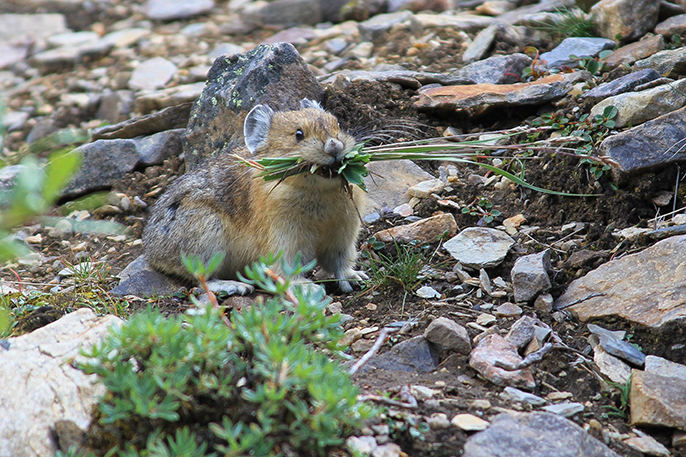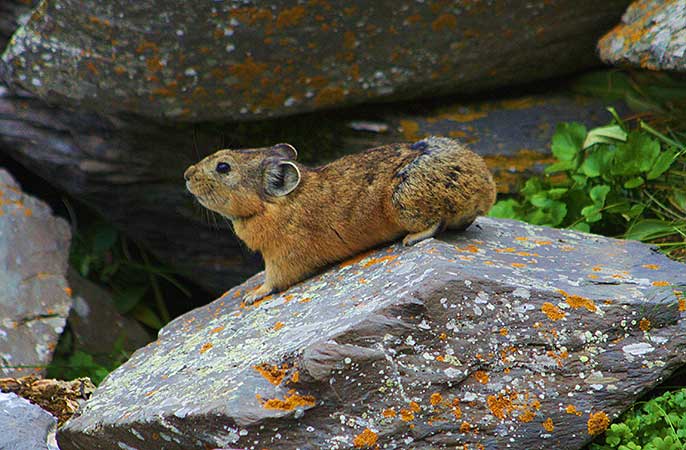
They spend part of their time looking out for predators, defending the territory and protecting their stored food. They can be quiet when a weasel is nearby to avoid being detected. The Pika will bark if they are scared and to warn other animals of danger that is near.


Pikas live in colonies divided into individual territories that they actively defend. They feed on alpine grasses, sedges, thistles, fireweed, cushion plants and lichens. It survives the cold winter by eating dried vegetation they have stored away in haypiles. What they eat: The Pika is herbivore that stays active year round even in winter. In Washington, the Pika is found living around talus slopes, rock piles, or boulder slides.įound in the Cascades and northeast regions of Washington.Ĭlick the range map to learn more about the distribution of Pika in Washington. They are often found at the interface between meadow habitat and open rocky terrain. Pikas are found in the rocky terrain in the mountain regionsįrom central British Columbia to South-Central California and east to Colorado. The body is egg-shaped and the underside is a buffy color.īody length: 162 to 216 mm (6 to 8.5 in). Pikas have rounded ears, light brown and gray fur, long whiskers and no visible tails. Rabbits, hares and pikas are related species. They are related to rabbits but are are about the size of large hamsters. NatureMapping Animal Facts for Kids American PikaĪmerican Pikas are hearty small mammals who live in rock piles in the mountains of western North America. We’re thrilled that we could spare Pika Pika from this fate and provide her with the care she needs until she’s ready to return to a wild life in Tsavo.American Pika Facts for Kids - NatureMapping It is not unusual for orphans, seeking protection from Tsavo’s notorious lions and hyenas, to latch onto bulls - but they sadly cannot provide the sustenance so vital for a milk-dependent calf’s survival, and the baby invariably gets left behind. As a result, human-wildlife conflict surged in the area, leaving many calves abandoned in the process. This year offered up another challenging dry season for wildlife, causing many elephants to leave the boundaries of Tsavo National Park in search of food. Although it’s unclear why Pika Pika was orphaned, we might guess at the reason. We rescued the calf from an area dominated by an imposing rock face called Pika Pika, so that name felt apt. Everyone enjoys coddling her, although Mbegu is quite strict with who is granted that privilege! Already, she is right in the thick of things, browsing in the bush and splashing at the mud bath, sandwiched in between the many loving members of her new family. She faces fierce competition as the older girls at Voi go crazy over younger babies and they were ecstatic to find a new arrival in their midst. Mbegu, unsurprisingly, quickly lay claim over the calf. The layout at Voi is such that her 'taming' stockade is situated within a larger stockade where Mbegu and her little herd sleep, so she was soon ensconced in the comforting presence of elephants once more and responded instantly. This decision clearly suited her although she was visibly stressed by the day’s events, she immediately tucked into the freshly cut greens waiting for her in the freshly prepared stockade. We decided to bypass the Nursery stage and instead raise her at our Voi Reintegration Unit not terribly far from where she was rescued. The rest of the rescue was fairly straightforward the bulls ambled onwards making no attempt to intervene while we swaddled the calf in blankets and prepared her for transport. The calf cooperated and peeled off from the bulls and headed right towards the Keepers. For everyone’s safety, our helicopter gently shepherded the group to the nearest road, where our rescue team was waiting to intercept. We knew that the calf’s chaperones, five wild bulls, would be a significant obstacle to contend with. After the photos confirmed her young age and the fact that she was indeed solely in the company of bulls, we mobilized a rescue. While we assembled a team from our Voi Reintegration Unit, which was the nearest stockade, our pilot flew to the scene to take high resolution photos of the calf.

Given the circumstances, KWS management requested the calf be rescued.Īs soon as the authorities notified us about the situation, we put a plan in place.

The nearest herd of elephants a long way away, and none of its lactating females appeared to be without their own calf. During aerial patrols of the Tsavo ecosystem, it’s not unusual to see small groups of elephants traversing the open plains, however, while on a routine flight over Taita Ranch on the morning of 5th September, Wildlife Works pilot Keith Hellyer spotted something that made him pause: a young, milk-dependent calf walking in the company of five adult bulls.


 0 kommentar(er)
0 kommentar(er)
